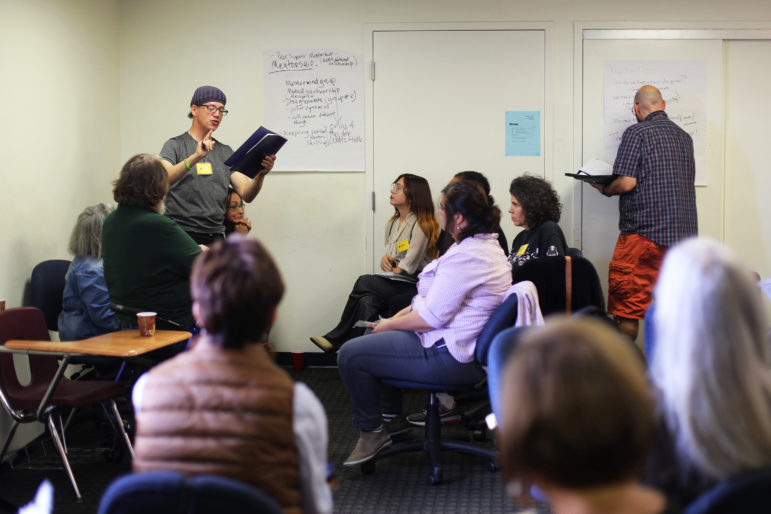
Jessie Roth
Peer mentors during a recent organizing meeting.
Unless you have direct experience with New York City’s mental health infrastructure, you are likely unaware of a unique set of professionals known as Peer Specialists, or Peer Workers. Peers are certified individuals with lived experience of mental health challenges who utilize that experience—in concert with additional training—to support others with similar issues. The peer workforce can often be found in clinical contexts working alongside nurses, psychiatrists, and social workers, but their role in psychiatric settings is being hotly contested.
Born out of the anti-psychiatry movements of the seventies and eighties, peers feel increasingly constrained by the clinicians they now call colleagues. Many feel they are being treated as second-class clinicians, a role which directly contradicts their intended purpose. This tension has some peers organizing outside the system once again, even as New York City becomes more and more dependent on this low-cost workforce.
“What I’m hearing from other peers now is that they’re not really being valued—they’re not doing the role that they were hired to do,” says Celia Brown, who was instrumental in developing the Peer Specialist civil service title for the NYS Office of Mental Health in 1994. “There needs to be a new paradigm where peers are valued and
validated for who they are. What they can contribute is just as valuable as what clinicians give.”
From ‘Insane Liberation’ to a regular role
In the sixties, seventies, and eighties, it would have been unconceivable for people with serious psychiatric histories to be employed within the mental health system. Individuals with clinical diagnoses were not only discriminated against, but regularly institutionalized, medicated, electrocuted, lobotomized, and subjected to other so-called “treatments” against their will. “The reason that I have a job in the mental health system is because there was a mental health Recovery Movement that basically started from this idea that people with mental illnesses can recover,” says Sascha Altman DuBrul, an organizer with a psychiatric history who trains peer specialists at the New York State Psychiatric Institute’s Center for Practice Innovations. “Our movement grew directly out of gains won by the Civil Rights, Women’s Liberation, LGBTQ and the Disability Rights Movements. We are indebted to the struggles of a lot of marginalized people who fought for their rights the way we are now fighting for ours.”
By the 1990s, waves of advocacy and activism—the Insane Liberation Front, the Antipsychiatry Movement, the Consumer/Survivor/Ex-Patient Movement, and others—had led to policy changes on every level of government as well as self-help models of treatment. The organizing principle was not only psychiatric justice for “consumers” of clinical services, but a reframing the whole goal of treatment to be “recovery focused.” Much of this work—including the development of peer support models—had happened outside the system. In 1989, the National Association of State Mental Health Program Directors formally endorsed peer contributions to mental health systems. In 1990, the Psychiatric Rehabilitation Journal declared the nineties “The Decade of Recovery.” In 1994, psychiatric survivor Celia Brown and psychiatrist Peter Stasny worked together to create the first Peer Specialist civil service position in the United States.
“Because of this movement, the federal government said, ‘You know, let’s fund some projects that deal with consumer run initiatives,'” remembers Brown, who today works for the state Office of Mental Health. “This opportunity came up where I could actually be who I am, use all my different experiences in treatment and in the movement to help others take control of their lives, to be in the community.”
Brown became New York’s first peer specialist, successfully inaugurating an era where people with lived experience of psychiatric conditions were recognized by the system specifically for their unique contributions. But the stigma of psychiatric history remained—for instance, Brown remembers that her clinical colleagues would make her and the other peers wait outside while they went over case notes.
“I felt so empowered, that I’m going to go work with different professionals, I’m going to work alongside with them in partnership,” remembers Brown. But what happened was, they weren’t excited to work with me and the other peer specialists, because they saw us as a liability. We were like clients to them.”
Numbers are growing, acceptance has stalled
In 2017 there were over 600 certified peer specialists in New York City alone, according to the Peer Workforce Consortium. That number has grown since the launch of ThriveNYC in 2015, Mayor de Blasio and First Lady McCray’s effort to overhaul the city’s mental health infrastructure, when the city pledged to train 200 certified peer specialists yearly beginning in fiscal year 2017.
Yet these gains have not tracked with acceptance of peers as equal partners in treatment. Stephanie Thompson, who became a certified peer specialist in 2015, says that one of her former employers—a prominent local social service agency—hosted monthly staff parties to which the peers were not invited, and that her clinical colleagues persisted in treating her like a client. “That type of stuff is institutional, and it’s what I ran up against, and it’s one of the reasons I’m not working in those agencies doing what I love to do,” says Thompson.
Jazmine Russell, a former peer who left the workforce disenchanted, has similar stories.
“I was there on a treatment team, and what I found was that the family members would ask the psychiatrist or whoever ‘what’s she doing here?’ And they’d go, ‘Oh, well that’s the person with lived experience,’” remembers Russell. “Some of the biggest conflicts that happened when I was a peer working within the system was the clinicians always making the decisions…Those types of things really show a power imbalance.”
As part of his role as a trainer for the Psychiatric Institute, DuBrul interviewed many peer specialists working within New York City and found that these problems—as well as low pay, a dearth of career advancement options and opportunities for training—were widespread.
“In the interviews it was pretty obvious that the peers were being systematically exploited and undervalued on their teams,” says DuBrul. “There was no job description so there was an incredible lack of clarity of the role, peers were getting paid way less than everyone else on the team and they were often doing just as much work and having to ‘prove themselves’ because they were diagnosed with a mental illness, and there was no career ladder to advance without taking a clinical job.”
“If peers were really valued in the system, they’d have multiple training programs, and different lenses of peer work,” says Russell. “We’d have holistic peer work, relational peer work, community organizing peer work. We’d have peers in every aspect of the treatment process.”
Organizing for change
The current state of affairs is a far cry from the intended purpose of peers, which was as a corrective for the chauvinism of clinicians ignorant of the ways systemic factors compound psychiatric distress. “How do we make sure that there’s peer roles that actually can have enough power and weight to them that there’s the ability to be transformative, the ability to actually change the model from the inside?” asks DuBrul. “What that would look like is if people organized.”
And organize they have: In the past few years, peers have begun making space for themselves on monthly conference calls, Facebook groups, and in person. In 2016, Russell—along with Stasny—co-founded an organization called the Institute for the Development of Human Arts, which in 2017, with DuBrul, Brown, and others, launched IDHA Peer Connection. IDHA Peer Connection is a monthly “community and capacity-building [gathering] of Peer Specialists who are fighting for their right to practice genuine peer support in their work places.” These meetings have been transformative for peers like Thompson.
“From the first time, IDHA was welcoming,” says Thompson. “It’s just amazing to connect with such talented people, who are open. I didn’t feel any stigma. There wasn’t a focus on your diagnosis. I don’t feel this paternalistic thing. There’s an even playing ground.”
IDHA Peer Connection has expanded to over 50 members and four peer committees, and is in the early stages of an organizing campaign built around a Declaration of Peer Roles. The initiative will begin with a survey sent to working peers across the city to be used to develop a scope of practice document. “The scope of practice thing is a real site of battle,” says DuBrul. “Without role clarity peer workers can end up doing all kinds of bullshit.” Once the declaration is complete, they plan to pressure the state Office of Mental Health, the city Department of Health and Mental Hygiene, and individual agencies to adopt it.
IDHA isn’t alone. On January 18, Community Access—one of the city’s leading advocacy organizations for people with mental health concerns—hosted a Community Feedback Forum of peers and longtime activists to inform Mayor de Blasio’s Crisis Prevention and Response Task Force’s forthcoming recommendations. Their specific proposals include integrating peers at all levels of the task force’s policy implementations, engaging peers in the policy decision-making of NYPD and the city relating to Crisis Intervention Teams, and increasing salaries and supports for peers in CIT work.
Get the best of City Limits news in your inbox.
Select any of our free weekly newsletters and stay informed on the latest policy-focused, independent news.
And on February 1, DuBrul led a specialized training for peer specialists working on Assertive Community Treatment teams from New York City and the Hudson Valley on “ACT Maps,” a set of questions designed to open up discussions about what care looks like for an individual. ACT Maps—then “Mad Maps,” was first developed by DuBrul and others as part of an anti-authoritarian collective of people with psychiatric histories called the Icarus Project in the early 2000s. Further trainings are anticipated.
Through these projects, New York City’s mobilized peer workforce hopes not only to reform the city’s mental health system, but to reshape it.
“Peer work is threatening to a lot of people,” says Russell. “Those of us who have a radical vision of what mental health could be are aiming for more peer support in the system precisely for the reason that peers can shake things up.”
Noah Phillips in an MSW candidate at the Columbia School of Social Work (Class of 2019) and the founder of the Media & Social Justice Caucus.


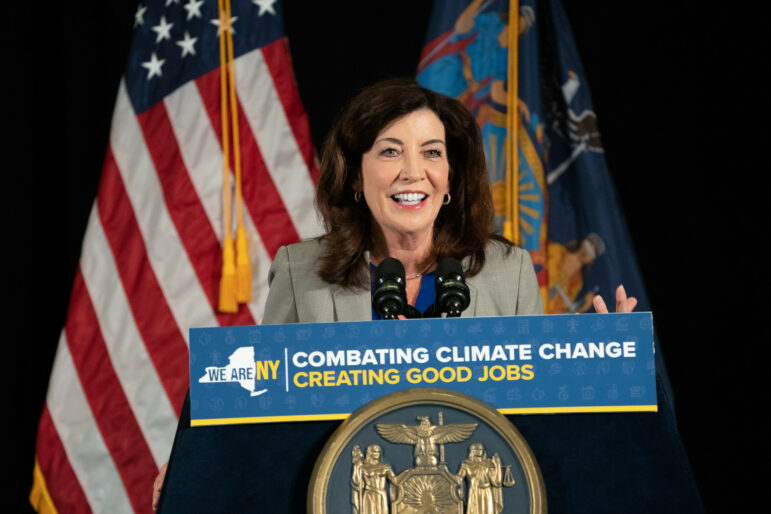

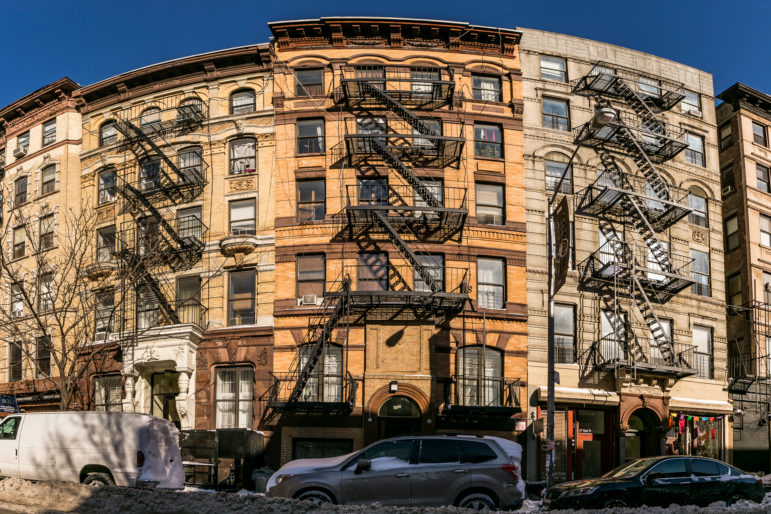
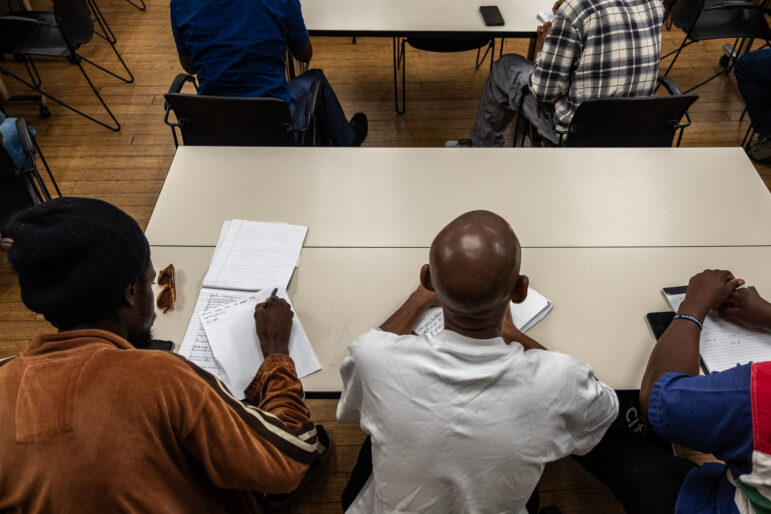
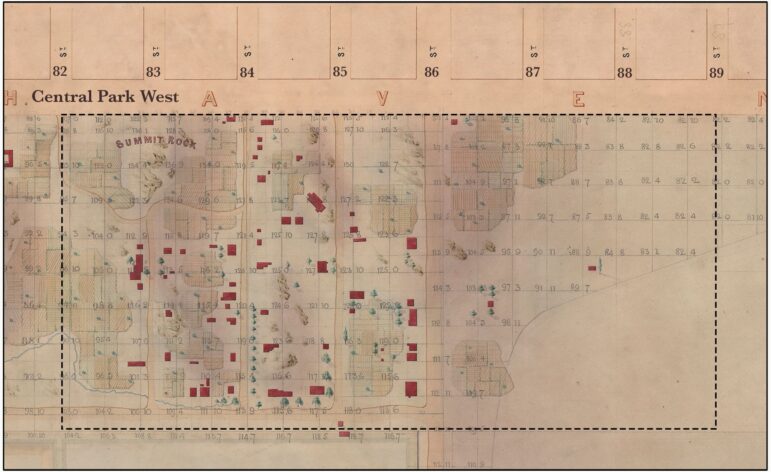


3 thoughts on “CityViews: Is New York’s Mental-Health System Listening to the Peers Who’ve Lived It?”
Who better understands challenges experienced from mental illnesss than someone with the disorder?
What an excellent and comprehensive article.
Pingback: CityViews: Is New York’s Mental-Health System Listening to the Peers Who’ve Lived It? - Maps to the Other Side